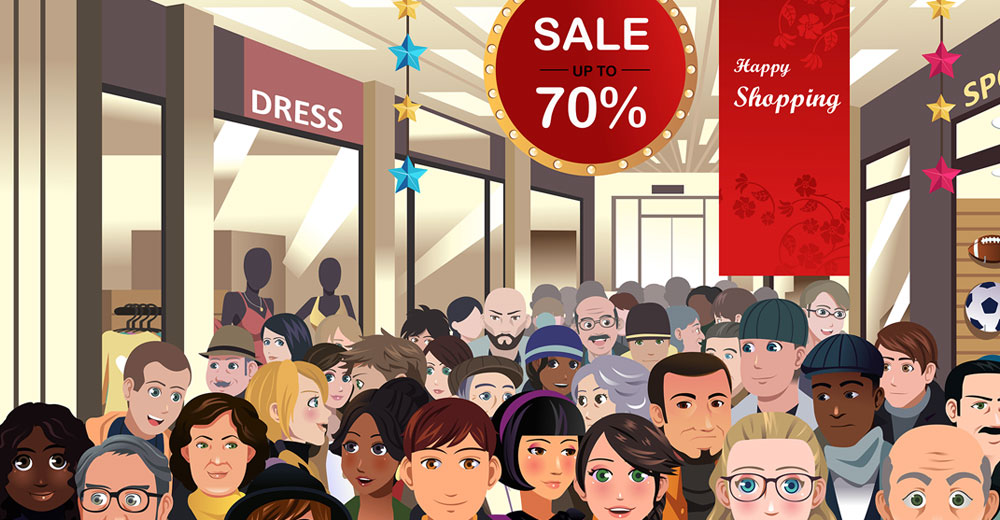Retailers: How many shoppers do you need to worry about this holiday season? The answer, it turns out, is five. Well, sort of.
In an 18-month global study of buying behavior, Epam Continuum discerned a critical pattern that today’s consumers fall into five broad categories of shoppers: the investigative consumer, the frivolous spender, the experience-driven buyer, the fluctuant shopper, and the conscious consumer.
To help organizations put these insights to work and optimize marketing efforts, retailers may want to focus on how to apply this pattern during the 2022 holiday season profitably.
Retailers must understand the buyers they’ll be meeting in the store, online, and over the phone. Each group knows what they want and is not shy about saying when sellers do not meet those expectations. So, let’s get ready for the rush.
A Practical Taxonomy of 5 Types of Shoppers
1. Investigative consumers view products as investments and do their research to locate the best value. They enjoy finding quality products at discounted prices.
‘Tis the season for discounts. The spending this season is projected to be up 7.1%, which is disappointing compared to 2021’s 8.5% increase. The current economic environment will have retailers heavily focused on investigative consumers. Thoughtful bargain shopping is a trend that’s taking hold, and retailers must acknowledge it. It may be that inflationary times make investigative consumers out of everyone to some degree.
With this group, Cameron Davis, head of digital strategy at Best Buy, says, “Ensuring that the right content and details are available on your website and in search terms is key.” He states that in addition to providing traditional online content, his organization is “building up a virtual store where we can have consumers easily speak over video with a virtual specialist within a category in a consultative way.”
Investigative consumers are inclined to shop for gifts online, where a wealth of information is at their fingertips. To win them over, retailers should provide detailed product information and specs, ratings and reviews, and competitive pricing.
Davis says there are real business benefits to retailers here. In an online setting, “improved monitoring and responsiveness to market changes are important.” This includes everything “from monitoring competitors for undercuts and pricing-arbitrage issues to ensuring better social listening to promote positive product points and fix negative product attributes.” Such digital intelligence will undoubtedly help retailers cut costs.
2. Frivolous spenders find joy in shopping, are not price-sensitive and have a shopping attitude characterized by spontaneity. They are making up for the lost time in the post-pandemic era.
It’s likely that, right now, the frivolous spenders are a minority of customers. Still, it’s worth thinking about them because they can be a good source of revenue. If a company provides a product or service these shoppers can’t resist, they proceed to checkout.
Businesses should offer these frivolous friends “special edition” items this holiday season that are only available for a limited time as they cannot resist once-in-a-lifetime opportunities.
In addition to creating unique offers and new-product-launch specials, Davis says retailers should “look for areas to deepen platform or bucketed buying. Look at whole categories jointly, such as living room, wardrobe, and AV equipment.”
These consumers don’t just want one-off products, says Davis. Instead, they will likely be “open to bucketing of goods and experiences.” He advises brands to “deepen membership perks and loyalty with this segment” because they are in “the current market for future stickiness.”
3. Experience-driven buyers are less focused on material possessions but are willing to spend loosely on experiences, such as travel and cultural or social activities.
People are again getting out of the house — into stores, restaurants, and the world at large. Retailers should think about this and consider which products pair best with experiences.
“Look to engage them within the physical store or in new virtual channels with something that allows for the aspirational trial of the product,” says Davis. He sees retailers rethinking what a physical store can be, how it can provide a truly unique experience, and “highlight products within their natural use cases.”
The experience-driven buyer is a tricky segment for retailers, as they are more likely to gravitate toward “experiential” gifts — a trip to Europe or a nice dinner. He suggests that retailers focus on marketing products with an experiential component, such as a new suitcase for the trip to Europe or a nice bottle of scotch to go with that dinner.
Finally, with regard to experience-driven buyers, Davis says retailers should consider partnerships. “For our retail stores, we often work closely with our vendor partners to ensure that our consumers can trial the product in-store in the best possible way.”
He points to partnership examples, such as West Elm’s REI collection or Delta’s Peloton on-screen classes, that have produced new areas of mutual benefit. The question is: With whom could your business most profitably partner?
4. Fluctuant shoppers can be frugal at most times but spend recklessly at others, depending on their mood or circumstances.
It’s hard to predict how the fluctuant shopper feels at any given moment, so retailers need salespeople and digital community managers who excel at reading customer moods.
The trick here is for retailers to provide a shopping experience that influences the mood of fluctuant shoppers to make them more inclined to spend. Interactions with store employees are often the most important and overlooked variable in the overall customer experience, so make sure to hire the right people this holiday season. Invest wisely in employees. A business may need to pay a little more, but the ROI can be significant.
For his part, Davis says that retailers should, with this group, try to be “top of mind, from a marketing and brand position, so that when the moment hits, they go to you.” He adds that employing “always-on marketing” and effectively using data and analytics may help retailers “find peaks and troughs of effectiveness in promotional activities.”
5. Conscious consumers can be influenced by the values of an organization, the quality of its products, and its environmental impact.
The holiday season doesn’t mean that customers will relinquish their values. In fact, for some people, shopping is a superb way to show their beliefs to friends and family. To ensure that retailers reach this segment, they must know what they stand for and communicate that.
It’s essential to provide transparency and, where possible, facilitate side-by-side comparisons of product attributes that enable consumers to make informed decisions. An example is Whole Foods Market and its use of a six-point scale, ranging from 1 to 5+, to rate the animal welfare standards of products in its meat department. This approach helps consumers live their values and conveys the company’s values by showing customers it agrees that the attribute is important.
Davis urges retailers to continue highlighting those values “which are authentic to your company. While we do not always see direct causation of spend due to espousing values, we do know that when there is a lack of authenticity or whitewashing, companies can face backlash.” In addition, he notes that ethical retailing is now tables stakes “in how we treat employees, which vendors we work with, and what we are willing to do to prove to the customer we are authentic.”















































